tire type TOYOTA AVALON HYBRID 2020 Warranties & Maintenance Guides (in English)
[x] Cancel search | Manufacturer: TOYOTA, Model Year: 2020, Model line: AVALON HYBRID, Model: TOYOTA AVALON HYBRID 2020Pages: 260, PDF Size: 8.54 MB
Page 128 of 260
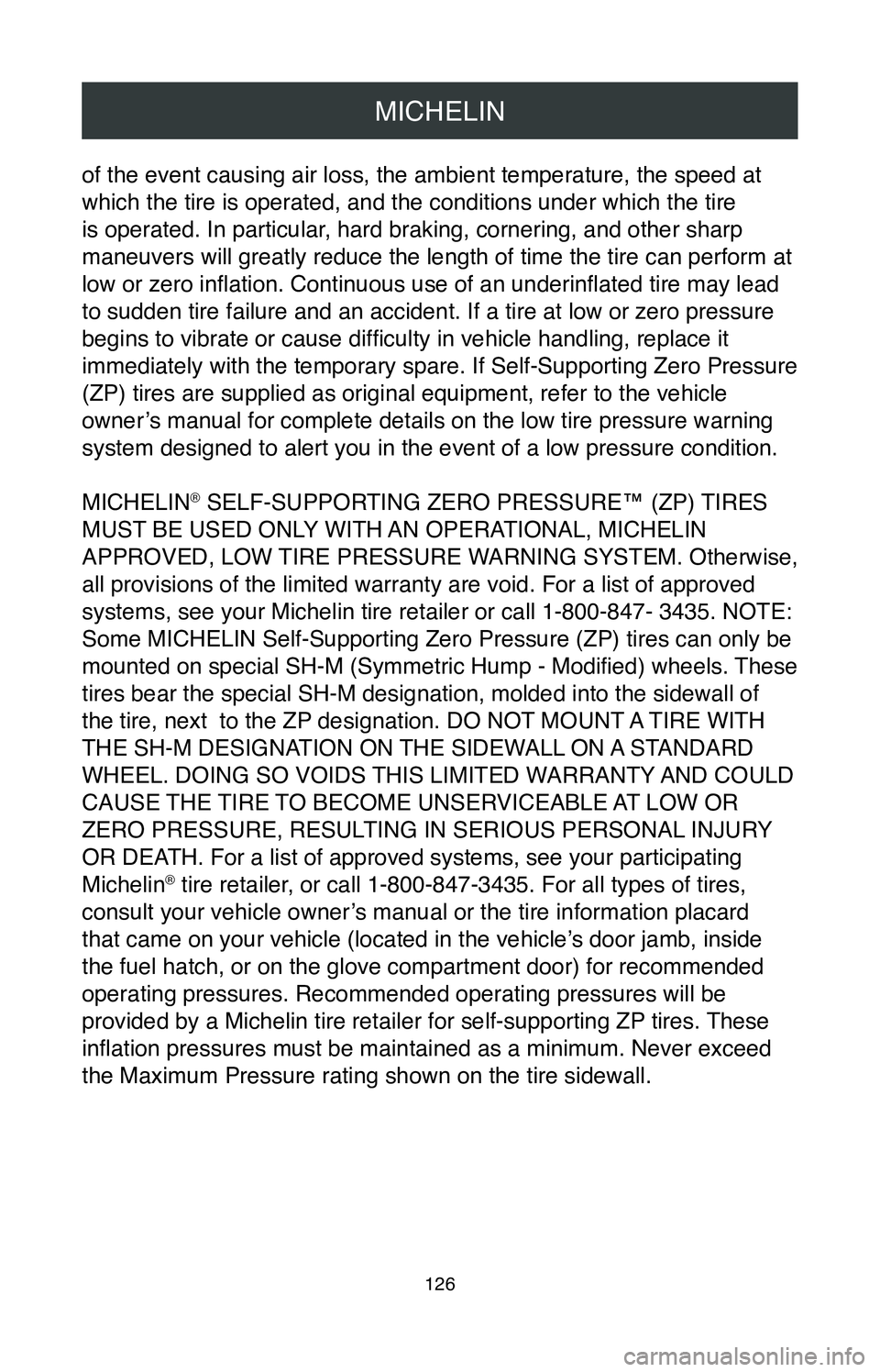
MICHELIN
126
of the event causing air loss, the ambient temperature, the speed at
which the tire is operated, and the conditions under which the tire
is operated. In particular, hard braking, cornering, and other sharp
maneuvers will greatly reduce the length of time the tire can perform at\
low or zero inflation. Continuous use of an underinflated tire may lead
to sudden tire failure and an accident. If a tire at low or zero pressur\
e
begins to vibrate or cause difficulty in vehicle handling, replace it
immediately with the temporary spare. If Self-Supporting Zero Pressure
(ZP) tires are supplied as original equipment, refer to the vehicle
owner’s manual for complete details on the low tire pressure warning
system designed to alert you in the event of a low pressure condition.
MICHELIN
® SELF-SUPPORTING ZERO PRESSURE™ (ZP) TIRES
MUST BE USED ONLY WITH AN OPERATIONAL, MICHELIN
APPROVED, LOW TIRE PRESSURE WARNING SYSTEM. Otherwise,
all provisions of the limited warranty are void. For a list of approved \
systems, see your Michelin tire retailer or call 1-800-847- 3435. NOTE:
Some MICHELIN Self-Supporting Zero Pressure (ZP) tires can only be
mounted on special SH-M (Symmetric Hump - Modified) wheels. These
tires bear the special SH-M designation, molded into the sidewall of
the tire, next to the ZP designation. DO NOT MOUNT A TIRE WITH
THE SH-M DESIGNATION ON THE SIDEWALL ON A STANDARD
WHEEL. DOING SO VOIDS THIS LIMITED WARRANTY AND COULD
CAUSE THE TIRE TO BECOME UNSERVICEABLE AT LOW OR
ZERO PRESSURE, RESULTING IN SERIOUS PERSONAL INJURY
OR DEATH. For a list of approved systems, see your participating
Michelin
® tire retailer, or call 1-800-847-3435. For all types of tires,
consult your vehicle owner’s manual or the tire information placard
that came on your vehicle (located in the vehicle’s door jamb, inside
the fuel hatch, or on the glove compartment door) for recommended
operating pressures. Recommended operating pressures will be
provided by a Michelin tire retailer for self-supporting ZP tires. These
inflation pressures must be maintained as a minimum. Never exceed
the Maximum Pressure rating shown on the tire sidewall.
Page 131 of 260
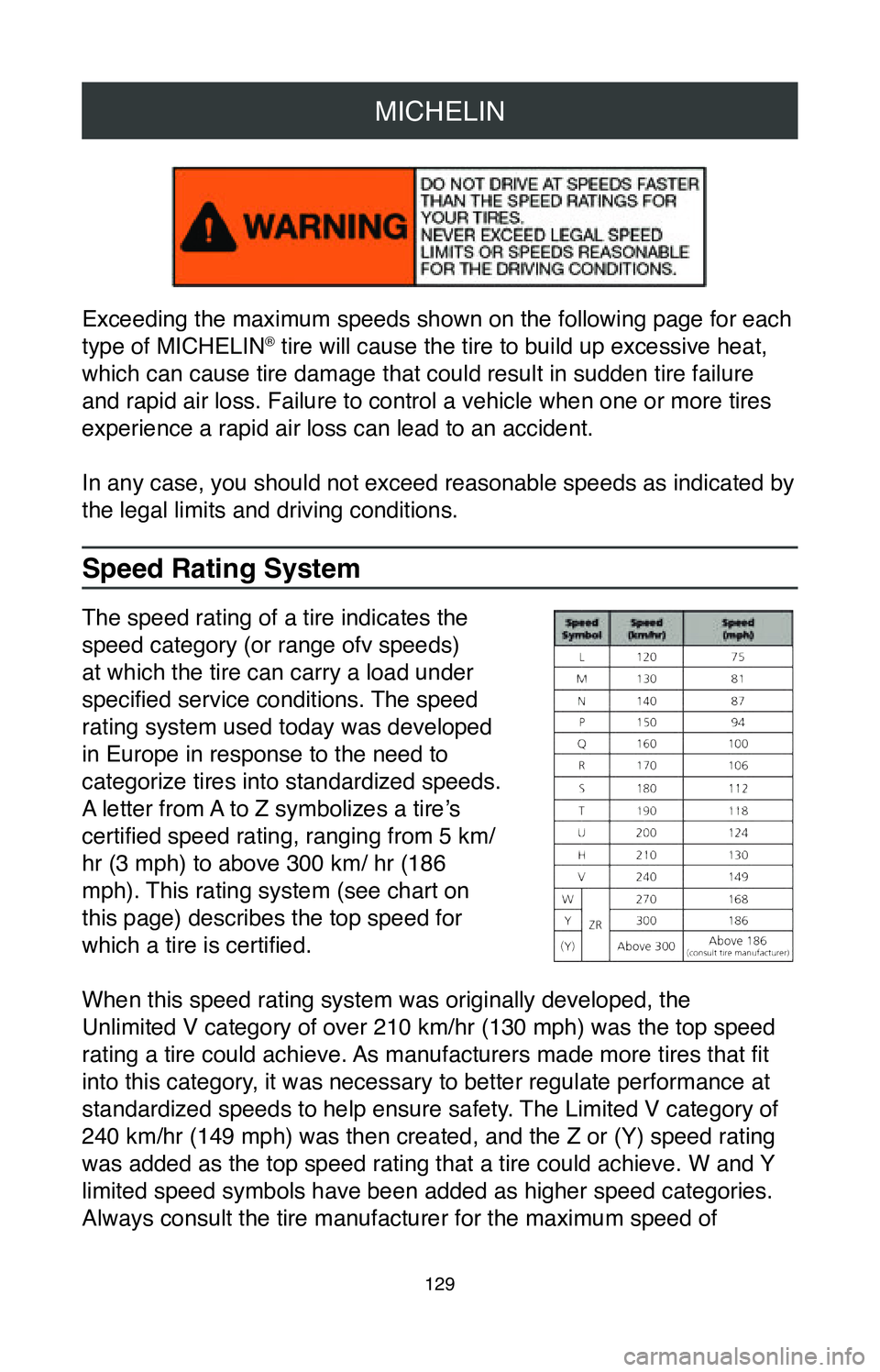
MICHELIN
129
Exceeding the maximum speeds shown on the following page for each
type of MICHELIN® tire will cause the tire to build up excessive heat,
which can cause tire damage that could result in sudden tire failure
and rapid air loss. Failure to control a vehicle when one or more tires \
experience a rapid air loss can lead to an accident.
In any case, you should not exceed reasonable speeds as indicated by
the legal limits and driving conditions.
Speed Rating System
The speed rating of a tire indicates the
speed category (or range of v speeds)
at which the tire can carry a load under
specified service conditions. The speed
rating system used today was developed
in Europe in response to the need to
categorize tires into standardized speeds.
A letter from A to Z symbolizes a tire’s
certified speed rating, ranging from 5 km/
hr (3 mph) to above 300 km/ hr (186
mph). This rating system (see chart on
this page) describes the top speed for
which a tire is certified.
When this speed rating system was originally developed, the
Unlimited V category of over 210 km/hr (130 mph) was the top speed
rating a tire could achieve. As manufacturers made more tires that fit
into this category, it was necessary to better regulate performance at
standardized speeds to help ensure safety. The Limited V category of
240 km/hr (149 mph) was then created, and the Z or (Y) speed rating
was added as the top speed rating that a tire could achieve. W and Y
limited speed symbols have been added as higher speed categories.
Always consult the tire manufacturer for the maximum speed of
Page 136 of 260
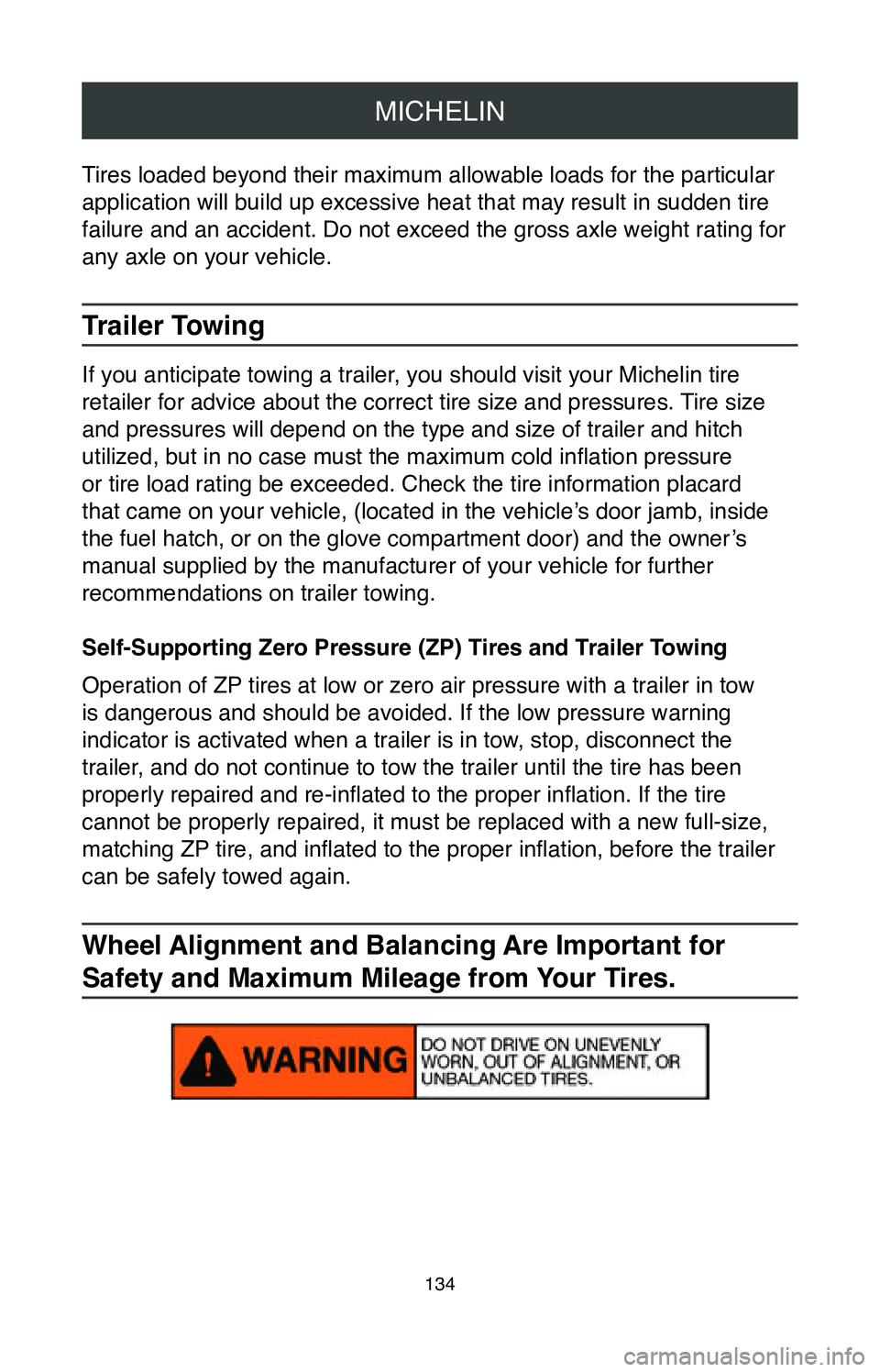
MICHELIN
134
Tires loaded beyond their maximum allowable loads for the particular
application will build up excessive heat that may result in sudden tire \
failure and an accident. Do not exceed the gross axle weight rating for \
any axle on your vehicle.
Trailer Towing
If you anticipate towing a trailer, you should visit your Michelin tire
retailer for advice about the correct tire size and pressures. Tire size
and pressures will depend on the type and size of trailer and hitch
utilized, but in no case must the maximum cold inflation pressure
or tire load rating be exceeded. Check the tire information placard
that came on your vehicle, (located in the vehicle’s door jamb, inside
the fuel hatch, or on the glove compartment door) and the owner’s
manual supplied by the manufacturer of your vehicle for further
recommendations on trailer towing.
Self-Supporting Zero Pressure (ZP) Tires and Trailer Towing
Operation of ZP tires at low or zero air pressure with a trailer in tow
is dangerous and should be avoided. If the low pressure warning
indicator is activated when a trailer is in tow, stop, disconnect the
trailer, and do not continue to tow the trailer until the tire has been
properly repaired and re-inflated to the proper inflation. If the tire
cannot be properly repaired, it must be replaced with a new full-size,
matching ZP tire, and inflated to the proper inflation, before the trailer
can be safely towed again.
Wheel Alignment and Balancing Are Important for
Safety and Maximum Mileage from Your Tires.
Page 137 of 260
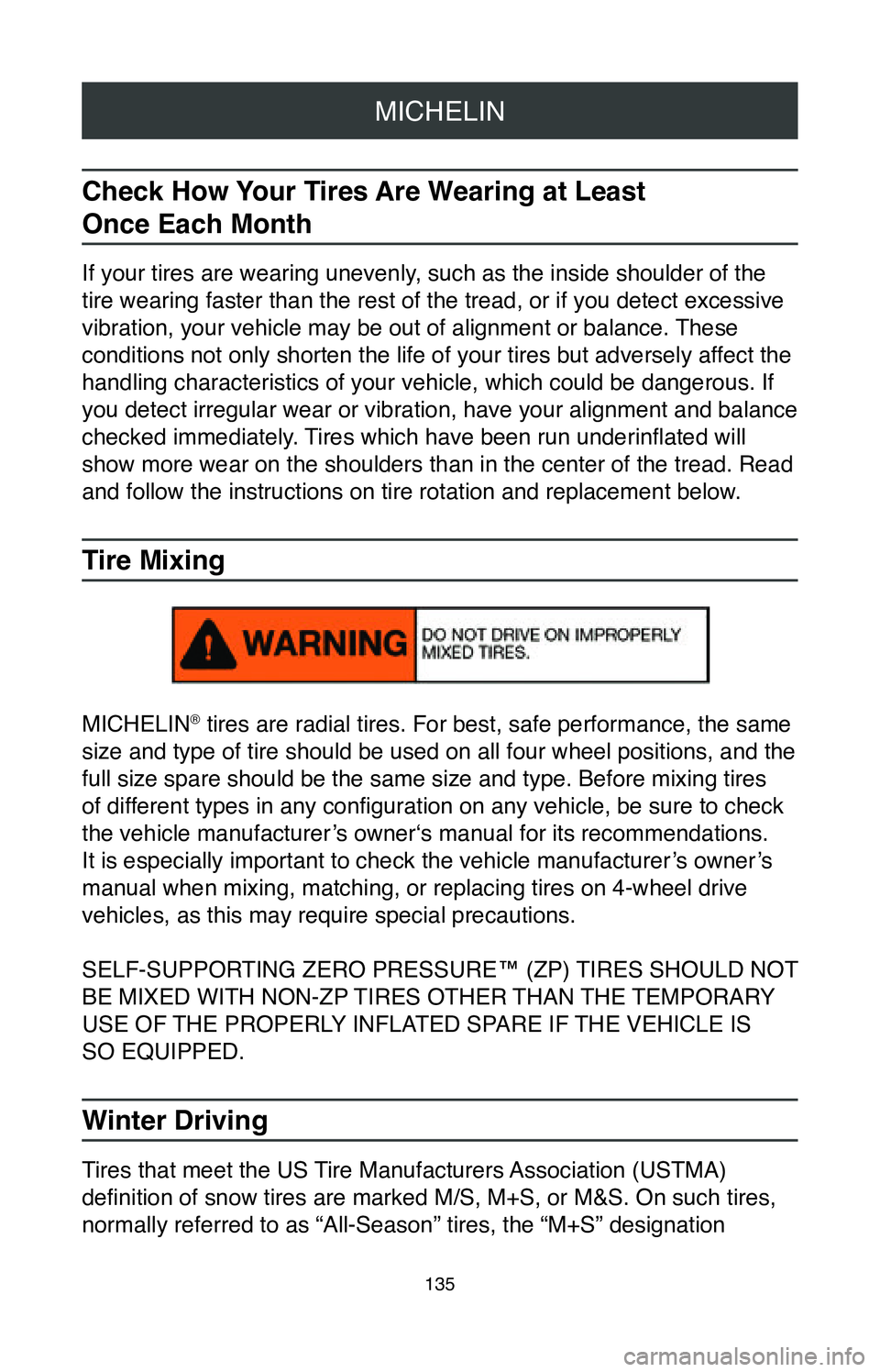
MICHELIN
135
Check How Your Tires Are Wearing at Least
Once Each Month
If your tires are wearing unevenly, such as the inside shoulder of the
tire wearing faster than the rest of the tread, or if you detect excessi\
ve
vibration, your vehicle may be out of alignment or balance. These
conditions not only shorten the life of your tires but adversely affect the
handling characteristics of your vehicle, which could be dangerous. If
you detect irregular wear or vibration, have your alignment and balance
checked immediately. Tires which have been run underinflated will
show more wear on the shoulders than in the center of the tread. Read
and follow the instructions on tire rotation and replacement below.
Tire Mixing
MICHELIN® tires are radial tires. For best, safe performance, the same
size and type of tire should be used on all four wheel positions, and th\
e
full size spare should be the same size and type. Before mixing tires
of different types in any configuration on any vehicle, be sure to check
the vehicle manufacturer’s owner‘s manual for its recommendations.
It is especially important to check the vehicle manufacturer’s owner’s
manual when mixing, matching, or replacing tires on 4-wheel drive
vehicles, as this may require special precautions.
SELF-SUPPORTING ZERO PRESSURE™ (ZP) TIRES SHOULD NOT
BE MIXED WITH NON-ZP TIRES OTHER THAN THE TEMPORARY
USE OF THE PROPERLY INFLATED SPARE IF THE VEHICLE IS
SO EQUIPPED.
Winter Driving
Tires that meet the US Tire Manufacturers Association (USTMA)
definition of snow tires are marked M/S, M+S, or M&S. On such tires,
normally referred to as “All-Season” tires, the “M+S” designation
Page 139 of 260
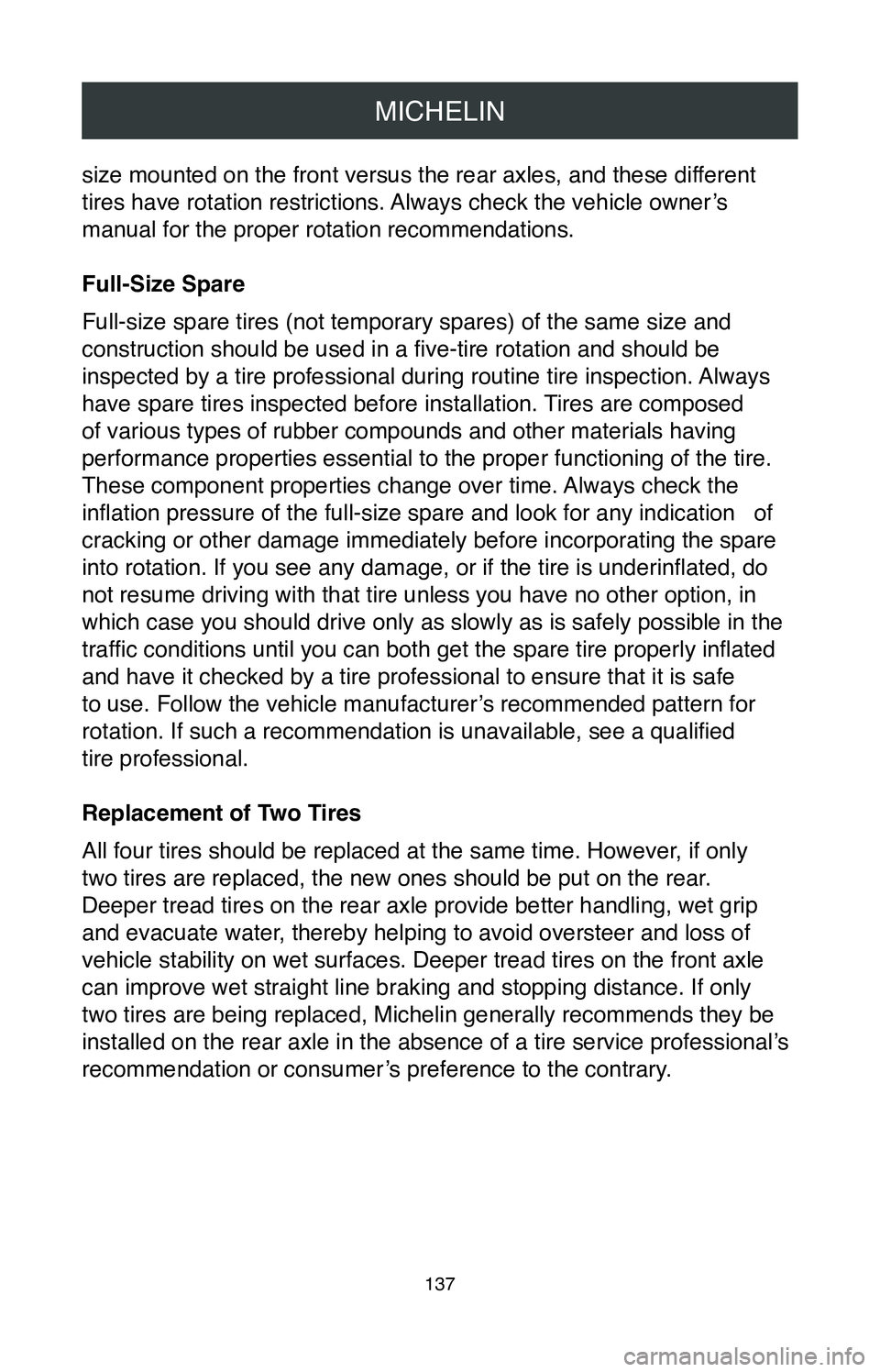
MICHELIN
137
size mounted on the front versus the rear axles, and these different
tires have rotation restrictions. Always check the vehicle owner’s
manual for the proper rotation recommendations.
Full-Size Spare
Full-size spare tires (not temporary spares) of the same size and
construction should be used in a five-tire rotation and should be
inspected by a tire professional during routine tire inspection. Always
have spare tires inspected before installation. Tires are composed
of various types of rubber compounds and other materials having
performance properties essential to the proper functioning of the tire. \
These component properties change over time. Always check the
inflation pressure of the full-size spare and look for any indication of
cracking or other damage immediately before incorporating the spare
into rotation. If you see any damage, or if the tire is underinflated, do
not resume driving with that tire unless you have no other option, in
which case you should drive only as slowly as is safely possible in the \
traffic conditions until you can both get the spare tire properly inflated
and have it checked by a tire professional to ensure that it is safe
to use. Follow the vehicle manufacturer’s recommended pattern for
rotation. If such a recommendation is unavailable, see a qualified
tire professional.
Replacement of Two Tires
All four tires should be replaced at the same time. However, if only
two tires are replaced, the new ones should be put on the rear.
Deeper tread tires on the rear axle provide better handling, wet grip
and evacuate water, thereby helping to avoid oversteer and loss of
vehicle stability on wet surfaces. Deeper tread tires on the front axle \
can improve wet straight line braking and stopping distance. If only
two tires are being replaced, Michelin generally recommends they be
installed on the rear axle in the absence of a tire service professional’ s
recommendation or consumer’s preference to the contrary.
Page 140 of 260
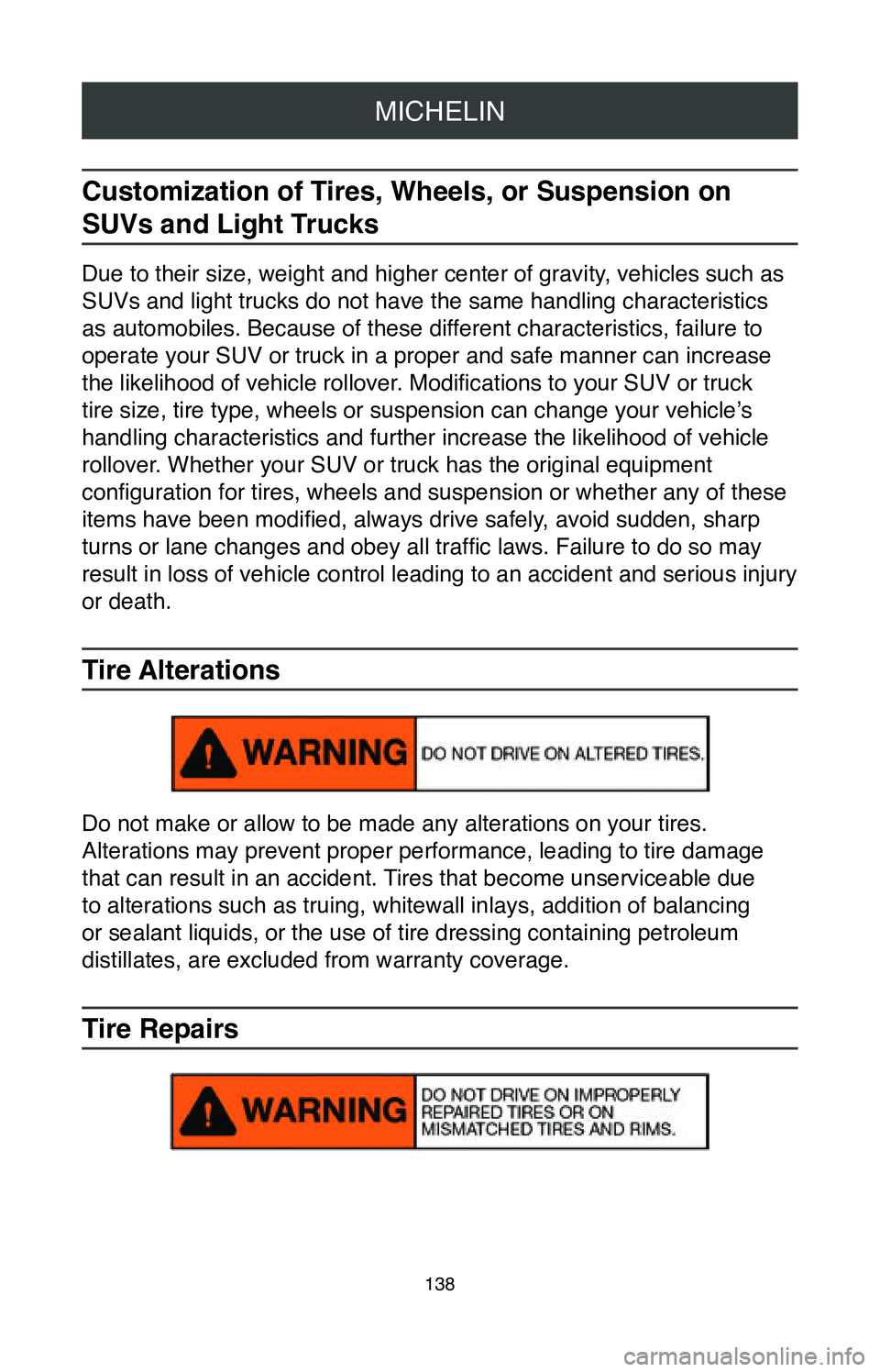
MICHELIN
138
Customization of Tires, Wheels, or Suspension on
SUVs and Light Trucks
Due to their size, weight and higher center of gravity, vehicles such as
SUVs and light trucks do not have the same handling characteristics
as automobiles. Because of these different characteristics, failure to
operate your SUV or truck in a proper and safe manner can increase
the likelihood of vehicle rollover. Modifications to your SUV or truck
tire size, tire type, wheels or suspension can change your vehicle’s
handling characteristics and further increase the likelihood of vehicle \
rollover. Whether your SUV or truck has the original equipment
configuration for tires, wheels and suspension or whether any of these
items have been modified, always drive safely, avoid sudden, sharp
turns or lane changes and obey all traffic laws. Failure to do so may
result in loss of vehicle control leading to an accident and serious injury
or death.
Tire Alterations
Do not make or allow to be made any alterations on your tires.
Alterations may prevent proper performance, leading to tire damage
that can result in an accident. Tires that become unserviceable due
to alterations such as truing, whitewall inlays, addition of balancing
or sealant liquids, or the use of tire dressing containing petroleum
distillates, are excluded from warranty coverage.
Tire Repairs
Page 141 of 260
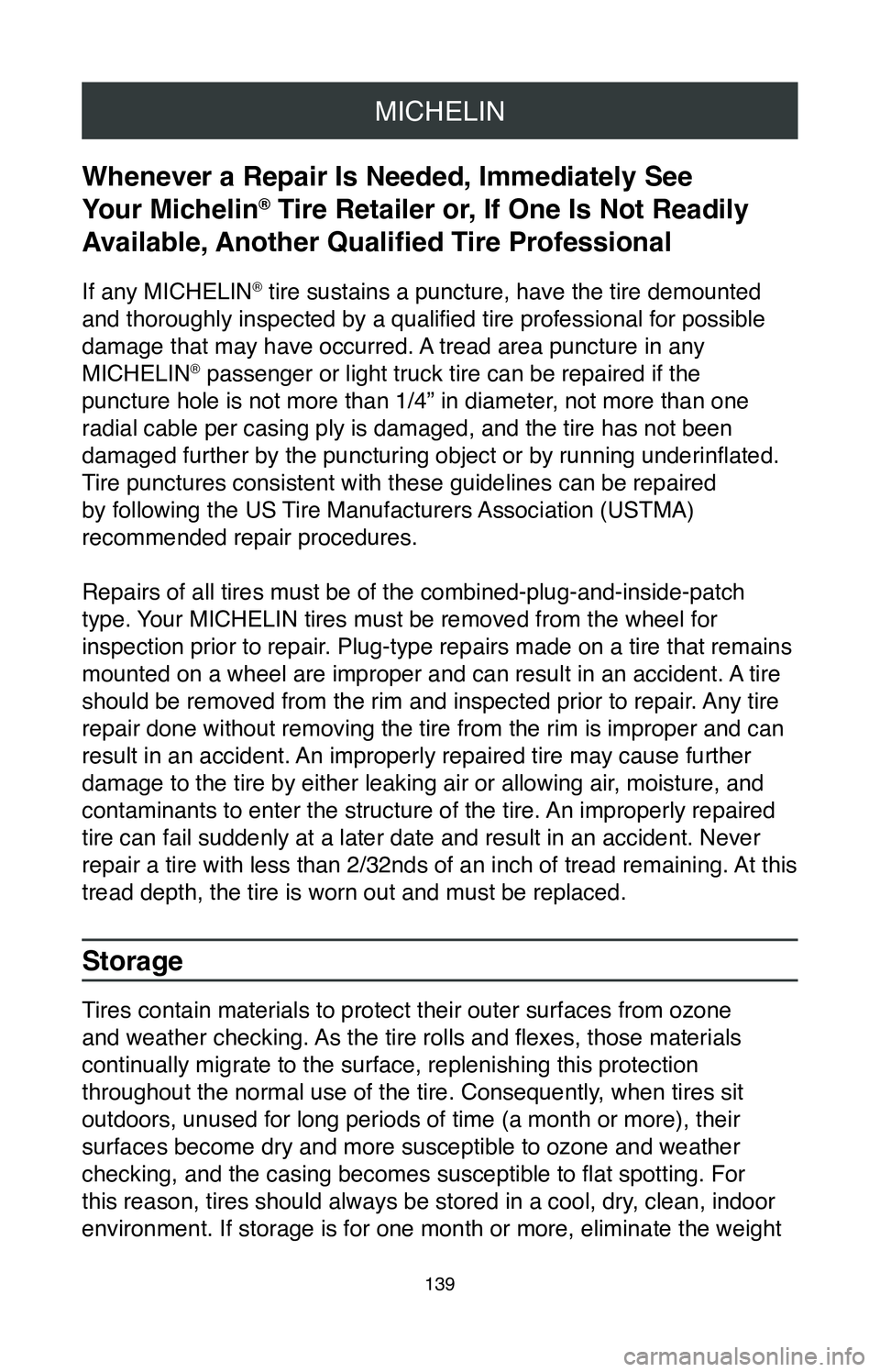
MICHELIN
139
Whenever a Repair Is Needed, Immediately See
Your Michelin
® Tire Retailer or, If One Is Not Readily
Available, Another Qualified Tire Professional
If any MICHELIN® tire sustains a puncture, have the tire demounted
and thoroughly inspected by a qualified tire professional for possible
damage that may have occurred. A tread area puncture in any
MICHELIN
® passenger or light truck tire can be repaired if the
puncture hole is not more than 1/4” in diameter, not more than one
radial cable per casing ply is damaged, and the tire has not been
damaged further by the puncturing object or by running underinflated.
Tire punctures consistent with these guidelines can be repaired
by following the US Tire Manufacturers Association (USTMA)
recommended repair procedures.
Repairs of all tires must be of the combined-plug-and-inside-patch
type. Your MICHELIN tires must be removed from the wheel for
inspection prior to repair. Plug-type repairs made on a tire that remains
mounted on a wheel are improper and can result in an accident. A tire
should be removed from the rim and inspected prior to repair. Any tire
repair done without removing the tire from the rim is improper and can
result in an accident. An improperly repaired tire may cause further
damage to the tire by either leaking air or allowing air, moisture, and
contaminants to enter the structure of the tire. An improperly repaired
tire can fail suddenly at a later date and result in an accident. Never \
repair a tire with less than 2/32nds of an inch of tread remaining. At this
tread depth, the tire is worn out and must be replaced.
Storage
Tires contain materials to protect their outer surfaces from ozone
and weather checking. As the tire rolls and flexes, those materials
continually migrate to the surface, replenishing this protection
throughout the normal use of the tire. Consequently, when tires sit
outdoors, unused for long periods of time (a month or more), their
surfaces become dry and more susceptible to ozone and weather
checking, and the casing becomes susceptible to flat spotting. For
this reason, tires should always be stored in a cool, dry, clean, indoor
environment. If storage is for one month or more, eliminate the weight
Page 142 of 260
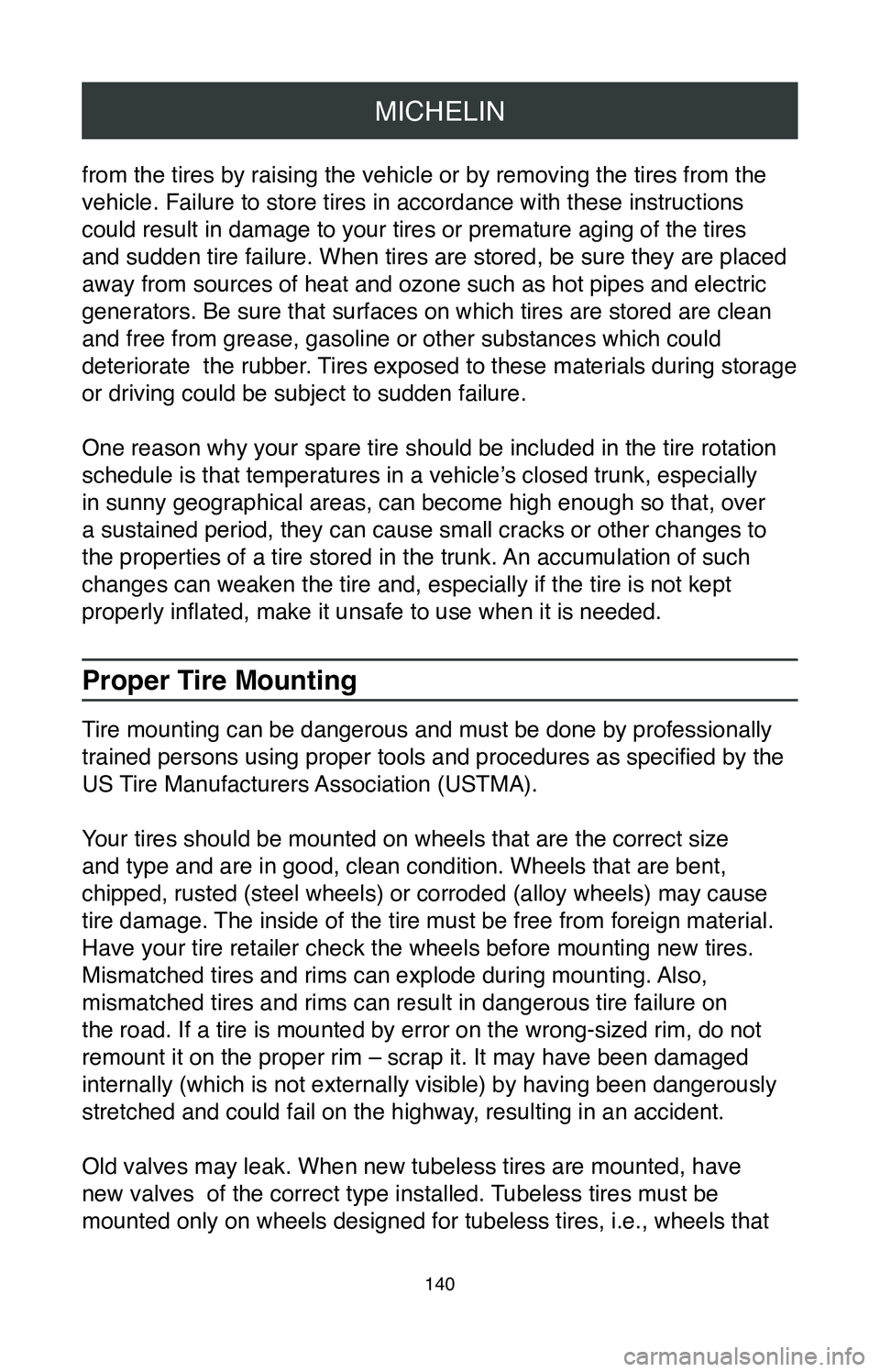
MICHELIN
140
from the tires by raising the vehicle or by removing the tires from the \
vehicle. Failure to store tires in accordance with these instructions
could result in damage to your tires or premature aging of the tires
and sudden tire failure. When tires are stored, be sure they are placed \
away from sources of heat and ozone such as hot pipes and electric
generators. Be sure that surfaces on which tires are stored are clean
and free from grease, gasoline or other substances which could
deteriorate the rubber. Tires exposed to these materials during storage
or driving could be subject to sudden failure.
One reason why your spare tire should be included in the tire rotation
schedule is that temperatures in a vehicle’s closed trunk, especially
in sunny geographical areas, can become high enough so that, over
a sustained period, they can cause small cracks or other changes to
the properties of a tire stored in the trunk. An accumulation of such
changes can weaken the tire and, especially if the tire is not kept
properly inflated, make it unsafe to use when it is needed.
Proper Tire Mounting
Tire mounting can be dangerous and must be done by professionally
trained persons using proper tools and procedures as specified by the
US Tire Manufacturers Association (USTMA).
Your tires should be mounted on wheels that are the correct size
and type and are in good, clean condition. Wheels that are bent,
chipped, rusted (steel wheels) or corroded (alloy wheels) may cause
tire damage. The inside of the tire must be free from foreign material.
Have your tire retailer check the wheels before mounting new tires.
Mismatched tires and rims can explode during mounting. Also,
mismatched tires and rims can result in dangerous tire failure on
the road. If a tire is mounted by error on the wrong-sized rim, do not
remount it on the proper rim – scrap it. It may have been damaged
internally (which is not externally visible) by having been dangerously
stretched and could fail on the highway, resulting in an accident.
Old valves may leak. When new tubeless tires are mounted, have
new valves of the correct type installed. Tubeless tires must be
mounted only on wheels designed for tubeless tires, i.e., wheels that
Page 143 of 260
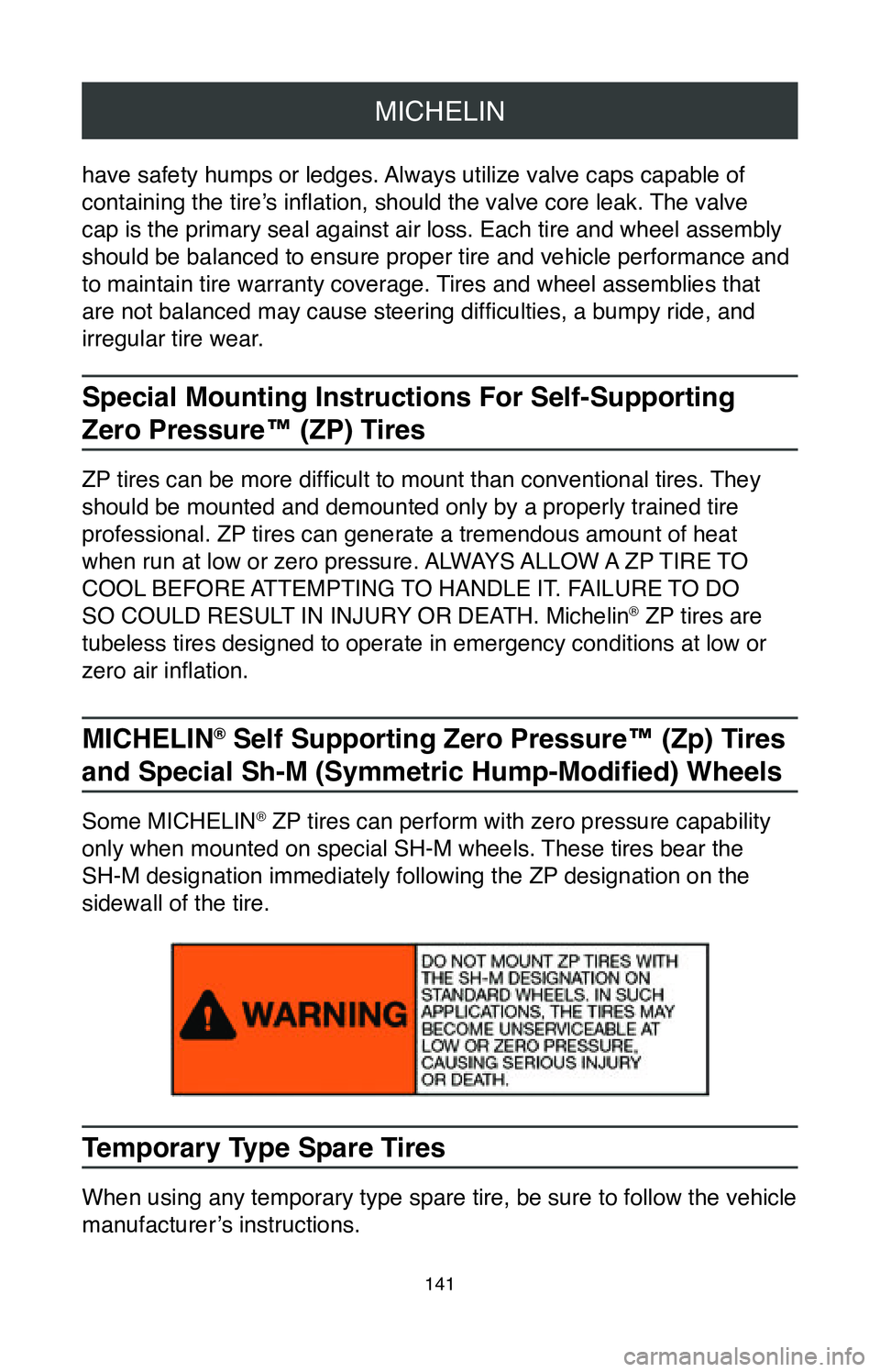
MICHELIN
141
have safety humps or ledges. Always utilize valve caps capable of
containing the tire’s inflation, should the valve core leak. The valve
cap is the primary seal against air loss. Each tire and wheel assembly
should be balanced to ensure proper tire and vehicle performance and
to maintain tire warranty coverage. Tires and wheel assemblies that
are not balanced may cause steering difficulties, a bumpy ride, and
irregular tire wear.
Special Mounting Instructions For Self-Supporting
Zero Pressure™ (ZP) Tires
ZP tires can be more difficult to mount than conventional tires. They
should be mounted and demounted only by a properly trained tire
professional. ZP tires can generate a tremendous amount of heat
when run at low or zero pressure. ALWAYS ALLOW A ZP TIRE TO
COOL BEFORE ATTEMPTING TO HANDLE IT. FAILURE TO DO
SO COULD RESULT IN INJURY OR DEATH. Michelin
® ZP tires are
tubeless tires designed to operate in emergency conditions at low or
zero air inflation.
MICHELIN® Self Supporting Zero Pressure™ (Zp) Tires
and Special Sh-M (Symmetric Hump-Modified) Wheels
Some MICHELIN® ZP tires can perform with zero pressure capability
only when mounted on special SH-M wheels. These tires bear the
SH-M designation immediately following the ZP designation on the
sidewall of the tire.
Temporary Type Spare Tires
When using any temporary type spare tire, be sure to follow the vehicle \
manufacturer’s instructions.
Page 144 of 260
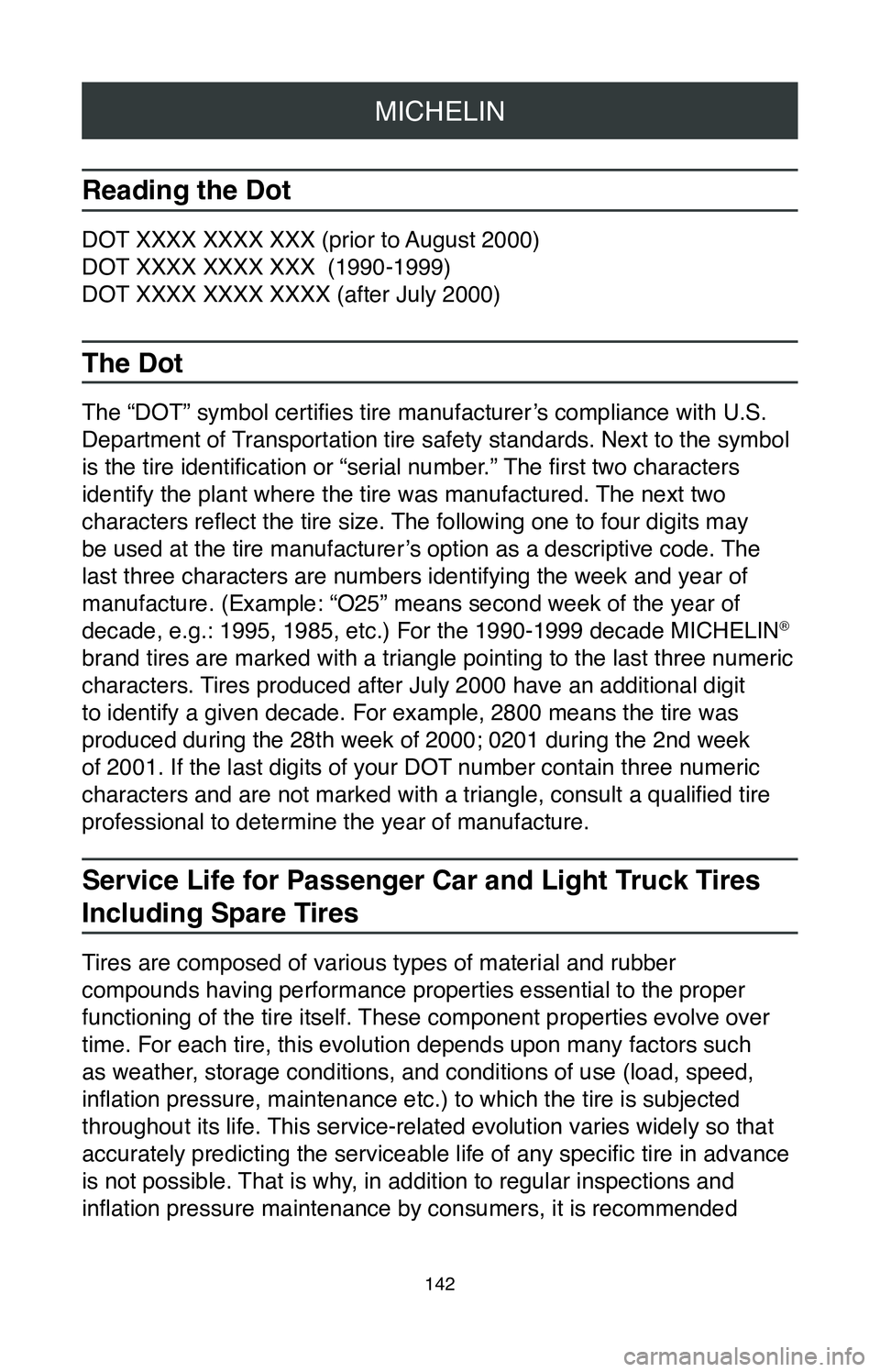
MICHELIN
142
Reading the Dot
DOT XXXX XXXX XXX (prior to August 2000)
DOT XXXX XXXX XXX
(1990-1999)
DOT XXXX XXXX XXXX (after July 2000)
The Dot
The “DOT” symbol certifies tire manufacturer’s compliance with U.S.
Department of Transportation tire safety standards. Next to the symbol
is the tire identification or “serial number.” The first two characters
identify the plant where the tire was manufactured. The next two
characters reflect the tire size. The following one to four digits may
be used at the tire manufacturer’s option as a descriptive code. The
last three characters are numbers identifying the week and year of
manufacture. (Example: “O25” means second week of the year of
decade, e.g.: 1995, 1985, etc.) For the 1990-1999 decade MICHELIN
®
brand tires are marked with a triangle pointing to the last three numeri\
c
characters. Tires produced after July 2000 have an additional digit
to identify a given decade. For example, 2800 means the tire was
produced during the 28th week of 2000; 0201 during the 2nd week
of 2001. If the last digits of your DOT number contain three numeric
characters and are not marked with a triangle, consult a qualified tire
professional to determine the year of manufacture.
Service Life for Passenger Car and Light Truck Tires
Including Spare Tires
Tires are composed of various types of material and rubber
compounds having performance properties essential to the proper
functioning of the tire itself. These component properties evolve over
time. For each tire, this evolution depends upon many factors such
as weather, storage conditions, and conditions of use (load, speed,
inflation pressure, maintenance etc.) to which the tire is subjected
throughout its life. This service-related evolution varies widely so that
accurately predicting the serviceable life of any specific tire in advance
is not possible. That is why, in addition to regular inspections and
inflation pressure maintenance by consumers, it is recommended